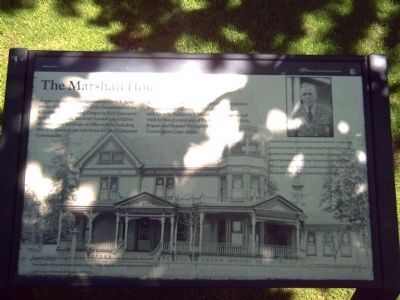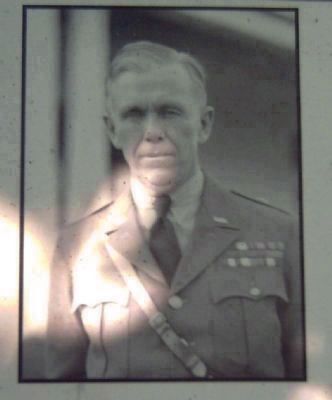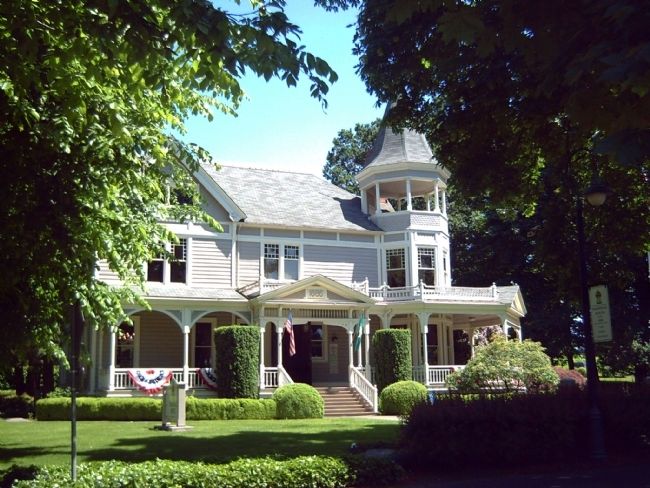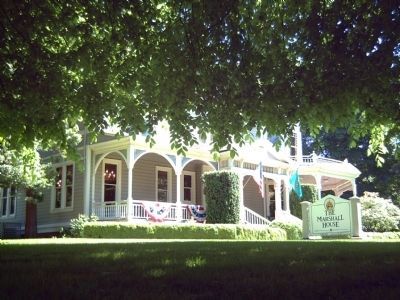Hudson Bay in Vancouver in Clark County, Washington — The American West (Northwest)
The Marshall House
— Officers Row —
The most famous individual to live in the residence, Brigadier General George Marshall, lived here with his wife, Katherine T. Marshall, from 1936 to 1938 while he was in command of the U.S. Army's Fifth Brigade and directed the region’s Civilian Conservation Corps camps.
Erected by Vancouver National Historic Reserve.
Topics and series. This historical marker is listed in these topic lists: Architecture • Forts and Castles. In addition, it is included in the Civilian Conservation Corps (CCC) series list. A significant historical year for this entry is 1878.
Location. 45° 37.637′ N, 122° 39.434′ W. Marker is in Vancouver, Washington, in Clark County. It is in Hudson Bay. Marker is on E. Evergreen Boulevard, on the left when traveling east. Touch for map. Marker is at or near this postal address: 1301 E Evergreen Blvd, Vancouver WA 98661, United States of America. Touch for directions.
Other nearby markers. At least 8 other markers are within walking distance of this marker. First Japanese on the North American Continent (about 300 feet away, measured in a direct line); Officers Row (about 700 feet away); Whose Anchor? (about 700 feet away); The Grant House (about 700 feet away); Vancouver Barracks Parade Ground (about 800 feet away); a different marker also named Officers Row (about 800 feet away); Carlton Foster Bond (approx. 0.2 miles away); Early Aviation History in Vancouver (approx. 0.2 miles away). Touch for a list and map of all markers in Vancouver.
More about this marker. A picture of General Marhall adorns the upper right corner of the marker. It includes the following caption, "General Marshall, seen here at Vancouver Barracks, in 1937, went on to serve as Army Chief of Staff during World War II, then as Secretary of Defense and Secretary of State. He also served as the head of the American Red Cross. He received the Nobel Peace Prize in 1953 for his efforts to reconstruct postwar Europe under the Marshall Plan." The photo was provided for use on the marker, "courtesy of Mr. Dale Denny."
The background photo is provided for the marker courtesy of the Clark County Historical Museum (negative #P81.13.3). It includes the caption: Brigadier General George C. Marshall and his wife fondly remembered their stay in the Commander’s Quarters (seen here ca. 1900); “Thus began two of the happiest years of our life,.”
Regarding The Marshall House. Built in 1886, this Queen Anne Victorian replaced the Grant House as home for the commanding officer of the Department of the Columbia. The Marshall House enjoyed wide popularity in the 1880s and '90s as the center for sophisticated social activities in local military and civic circles. While serving as the commanding officer here from 1936-38, George C. Marshall resided in the house that now bears his name. Marshall later became U.S. Army Chief of Staff during World War II, Secretary of State and Secretary of Defense. He authored the Marshall Plan, which helped rebuild the economies of Western Europe and the Pacific Nations after World War II. General Marshall was awarded the Nobel Peace Prize in 1953 in recognition of these efforts. Today, the Marshall House is decorated with antiques from the 1880s. It is open to the public and can be reserved for conferences, public ceremonies and social gatherings.
Also see . . . Biography of George C. Marshall. Hosted on the The Nobel Foundation website. (Submitted on July 11, 2008, by Kevin W. of Stafford, Virginia.)
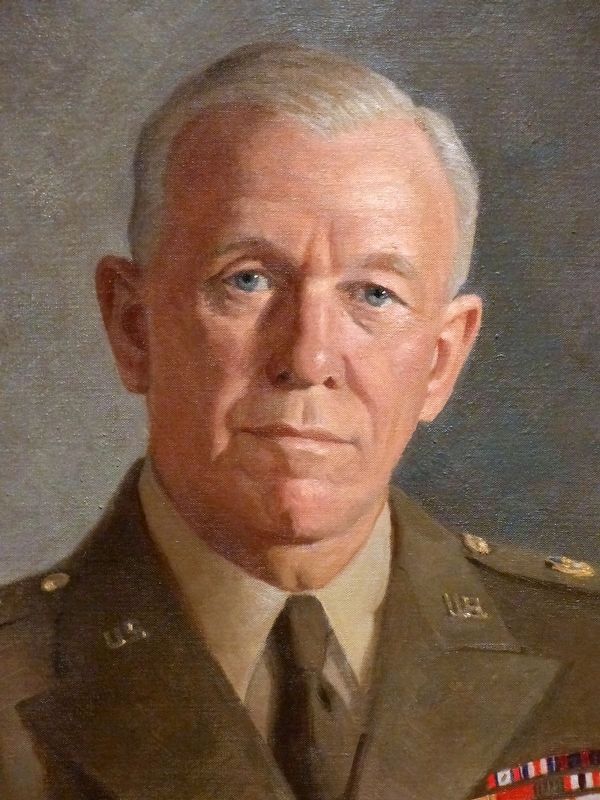
Photographed By Allen C. Browne, November 29, 2015
5. George C. Marshall
This c. 1949 portrait of George C. Marshall by Thomas E. Stephens hangs in the National Portrait Gallery in Washington, DC.
“George C. Marshall was, according to one expert observer, the ‘perfect’ soldier. Endowed with a quick mind, a good memory, and a superb sense of strategy, he did not particularly relish war. Yet as chief of staff during World War II, he proved to be a masterful orchestrator of military mobilization. In 1945 President Harry Truman remarked that millions of Americans had served the country well in that conflict, but it had been Marshall who ‘gave it victory.’ As capable in peace as in wartime, Marshall later became Truman's secretary of state, and it was he who unveiled in 1947 the American aid program for rebuilding Europe's war-ravaged economies. Ultimately named the Marshall Plan, this venture became one of the greatest triumphs in the entire history of American diplomacy. ” — National Portrait Gallery
“George C. Marshall was, according to one expert observer, the ‘perfect’ soldier. Endowed with a quick mind, a good memory, and a superb sense of strategy, he did not particularly relish war. Yet as chief of staff during World War II, he proved to be a masterful orchestrator of military mobilization. In 1945 President Harry Truman remarked that millions of Americans had served the country well in that conflict, but it had been Marshall who ‘gave it victory.’ As capable in peace as in wartime, Marshall later became Truman's secretary of state, and it was he who unveiled in 1947 the American aid program for rebuilding Europe's war-ravaged economies. Ultimately named the Marshall Plan, this venture became one of the greatest triumphs in the entire history of American diplomacy. ” — National Portrait Gallery
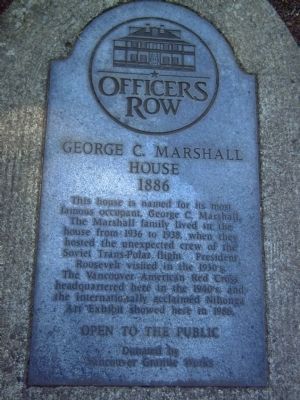
Photographed By Kevin W., June 13, 2008
6. Ground Marker on Officers Row
Donated by Vancouver Granite Works.
Credits. This page was last revised on February 7, 2023. It was originally submitted on July 7, 2008, by Kevin W. of Stafford, Virginia. This page has been viewed 1,831 times since then and 21 times this year. Photos: 1, 2, 3, 4. submitted on July 7, 2008, by Kevin W. of Stafford, Virginia. 5. submitted on October 23, 2017, by Allen C. Browne of Silver Spring, Maryland. 6. submitted on July 7, 2008, by Kevin W. of Stafford, Virginia.
